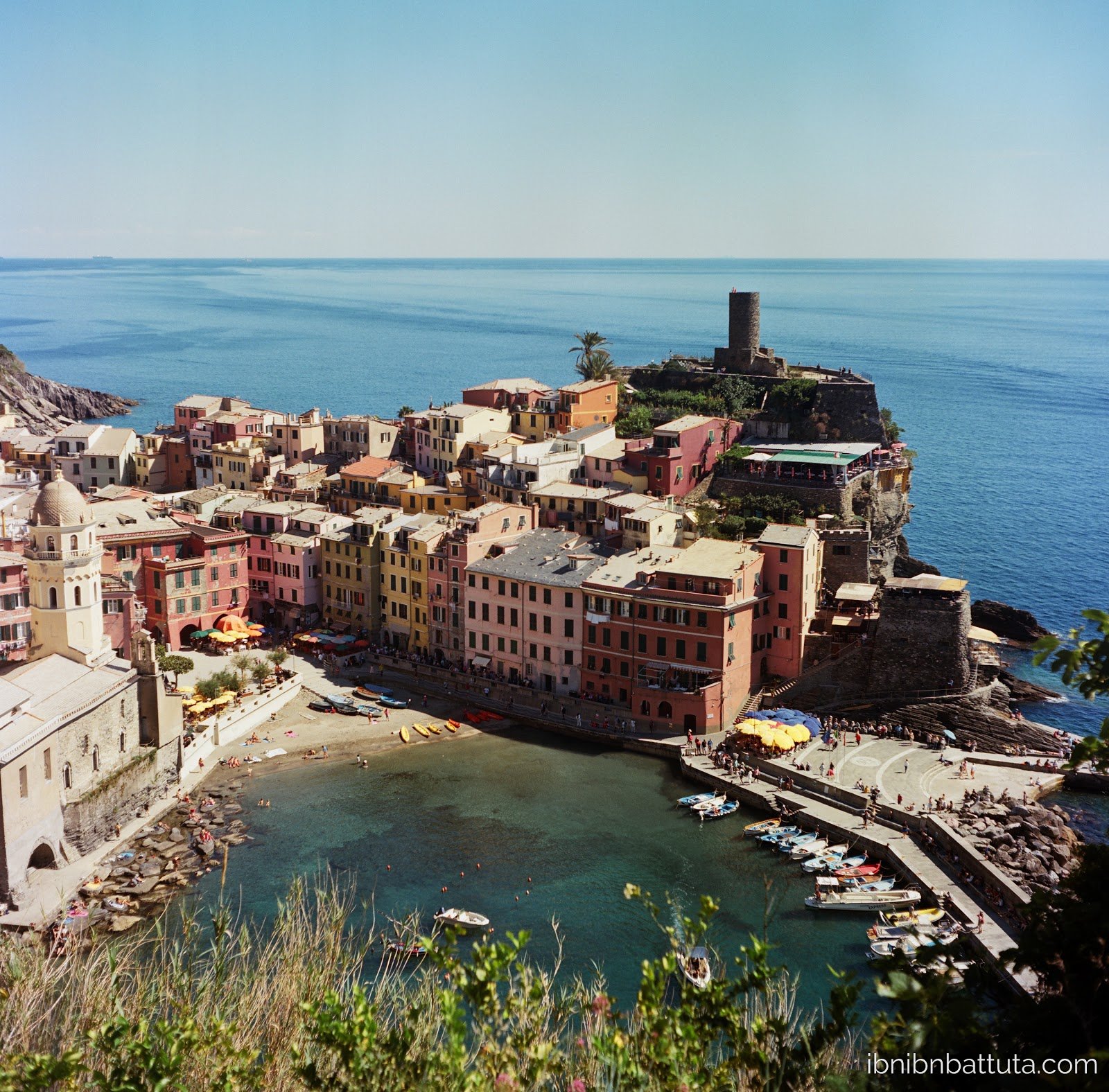From Tuscany to Cinque Terre, Sampling the Lavish and Relishing the Simple
A week-long trip through Tuscany and Cinque Terre offers much to love.
Vernazza, a picturesque paradise in Cinque Terre.
Still buzzing from the excitement of the sumptuous Roman wedding, Nina and I wrestled our bags into a rented Fiat and headed for Tuscany. It was still early May, so the days were long, the air was sun-baked and warm, and the Italian countryside was in bloom.
We drove to Orvieto, a medieval town whose defensive walls melded seamlessly into the rocky outcropping on which it sat, dominating the fields of grapes and orchards all around. In Orvieto we climbed the ancient bell tower, savored prosciutto and mozzarella sandwiches in a tiny shaded piazza, and strolled along stone streets flanked by gelaterias and artisan shops selling everything imaginable in gnarly hand-carved olive wood.
Siena's central tower overlooks the city and much of the surrounding countryside.
By the end of the day we had traversed Lazio, skirted Umbria, and entered Tuscany, where we settled for the night in a b&b outside Siena. It was a 15-minute walk to the central Piazza del Campo, the vast, seashell-shaped central plaza dominated by the city's famed tower. For two days each summer since the 1500s, thousands of spectators have crammed into the piazza at the spindly spire's base to watch the Palio di Siena, a breakneck sprint of a horse race—renowned for thrown riders, tumbled horses, and dramatic photographs—in which the city's main neighborhoods compete for glory. Nina and I were a few months too early to observe the race, but we did catch a parade of marching bands garbed in the colors and insignia of each neighborhood.
We explored more of Siena's steeply pitched lanes the next day, and even stumbled upon an exceptional camera shop where I stocked up on accessories for my Rolleicord.
Though we were too early for Siena's Palio, we happened upon a parade of marching bands.
Back on the road that afternoon, we soon reached our principal destination of this road trip—Cinque Terre. I had long heard about this magical little string of villages along the Ligurian Sea, famed for their rugged terrain and vibrantly painted houses. The rumors were true. Every one of the five villages was uniquely, strikingly beautiful—and photogenic. I haven't traveled many places where it was so easy to take great photographs. Just close your eyes, point the camera anywhere, and click away. With perfect blue waters and verdant hills all around and every building painted in invitingly warm hues, it's hard to miss.
Nina and I rented a room in Manarola, the second of the five tiny fishing ports, each wedged between precipitous peaks plunging into the sea.
Vernazza exemplified Cinque Terre's brilliant, colorful style.
On our first day there, we hit the trail. A network of hiking routes link the five villages, and (in typical fashion) Nina and I were determined to see them all in as short a time as possible.
The rocky paths ascended at a thigh-pounding pitch through terraced hills of grape vines, olive orchards, flowered meadows, and scrubby forest, before descending again to the next town. At Corniglia we watered up and trekked onward; at Vernazza we cooled off in the chilly sea then lunched on succulent gnocchi at the water's edge; and when we finally reached Monterosso al Mare—after eight hours of hiking—we collapsed into the sea, our joints aching and muscles throbbing. Luckily, by that time it was beer o'clock.
A view from the steep trail linking the five fishing villages of Cinque Terre.
Luckier still, some decades earlier the Italians had dynamited a tunnel through the mountains and installed a train. After a whole day of grueling trekking, the train delivered us back in Manarola in 15 minutes. There, we settled in at the cliff-side Nessun Dorma cafe for a sunset view of the town over cocktails and a cured-meat-and-cheese platter large enough to have satisfied a dozen.
The next morning we knocked off the last of the five villages, Riomaggiore, after one final, bitterly pitched climb that left me feeling like I very much deserved my lunch of yet more delicious seafood pasta and wine. And after one last quick hop on the train, we were back behind the wheel.
In Riomaggiore, we joined others in braving the Mediterranean's chilly springtime waters.
The final stop on our road trip was Valgiano, a hillside full of farmhouses (it seemed to small to qualify as a village) overlooking Lucca, a few hours' drive inland. After two intense weeks in Rome and on the road, it was finally time for the relaxing part of our vacation: a two-day stay at the Forestarìa b&b with absolutely nothing planned. It turned out to be the perfect place for relaxing: a rustic farmhouse without a thing to do but sit and read, watch the occasional chicken or dog shuffle past, and stroll amid the cherry, lemon, and olive orchards. I skipped lunch each day in anticipation of dinner at the area's lone restaurant, the Osteria da Giomo, a prix fixe spot with the disarming feel of a family dining room, where we enjoyed both the best food and best service of our entire Italian odyssey.
As our journey reached its end, every last succulent mouthful at the Osteria served as a useful reminder that, even if the beaten path leads to some understandably breathtaking destinations, in Italy as elsewhere it pays to head for the hills and find small communities of people who know how to do the simple things just right.
Forestarìa, in the hills above Lucca, was where we spent our trip's tranquil final days.







